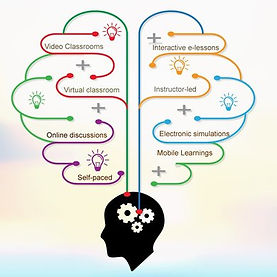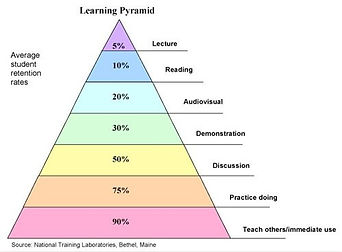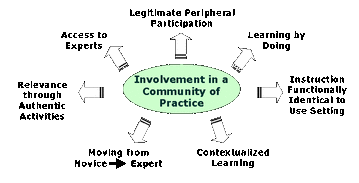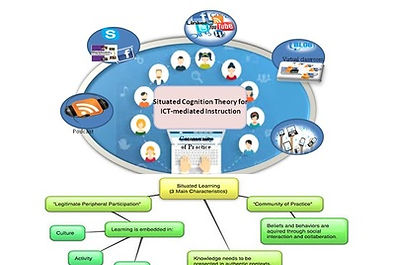
EDTK 2030: Information and Communication Technologies in Education
Assignment 3: Online Research (Option 1):
The Relevance of Situated Cognition in ICT Mediated Instruction
E-tutor: Debra- Dreana Marshall Stewart
Student: Shonella Morgan
October 30th 2015
Images courtesy: http://edtechreview.in/ and http://hlwiki.slais.ubc.ca/
Introduction
Purpose the vehicle that compels humans to survive and gives them the awareness of their exsistance, (Jonassen, 2000, p. 1). With the genesis of Information Communication Tools (ICT) the question is how can educators use these tools/instruments to ensure students learning and for what purpose can these tools be used? It is a fact that learning plays a major role in developing skills and knowledge. Hence, many learning theories have been developed over the years to show how people learn and these theories have enabled teachers to plan strategically for the learning outcomes of students. Consequently, there is a learning theory that is activity based, (Arnseth, 2008 cited in Unit 2 slide 11, & Jonassen, 2000, p. 1) whereby students learn from their actual involvement in authentic activities. This is depicted in the diagram below which shows the teaching method that has the greatest impact on students' learning:
This learning theory which is being referred to is called Situated Cognition Learning theory, which was developed by Lave and Wenger, (1991 cited in Stein, 2005). ‘Situate’ means, ‘where the learning is happening’. Therefore, situated learning is not restricted to or by a physical space, (Lave, 1991, p. 66), but rather it is the activities, context and culture where the learning is happening at the point in time, (Stein, 2005). Therefore, once students are provided with the right kind of environment where they can collaborate and engage their peers during the activities, learning will take place. Thus in the context of ICT- mediated instruction, situated cognition or learning is possible because ICT web 2.0 tools allow students and teachers to meet and communicate in a social and collaborative environment, (EDTK 2030, Unit 2, p. 58) irrespective of wherever they are in the world. The theme therefore of situated cognition is embedded in the idea that learning happens in a social context, while being involved in authentic activities, (Herrington & Oliver, n.d). Therefore, the relevance of situated cognition theory in ICT-mediated instruction is that it fosters collaboration and develops high order thinking skills.
Fostering collaborative learning is the core of situated cognition in ICT-mediated instruction. In this learning environment there is a community of practice where the group of individuals meet to learn a particular subject of interest and as they communicate with each other on the interest, they learn how to accomplish the task successfully because they have been meeting and discussing regularly, (Wenger, 2007 cited in Smith 2003-2009). Moreover, in the learning environment the characteristics seen are discussion, decision making, problem solving, inquiry and information sharing, (EDTK 2030, Unit 2, p. 58, Herrington & Oliver, n.d, Mills, 2011, p. 346, Collins, Browne, and Holum, 1991). Similarly, in ICT-mediated instruction, situated cognition theory is evidenced by the various aspects of the virtual classroom, (EDTK 2030, Unit 2, p. 59). where students have the independence and responsibility for their learning as they complete activities, communicate with their peers and teacher, ask questions, receive and share information, (Reiner, 2014), as well as to listen to recorded sessions for example with the Blackboard Elluminate that allows for chat, sharing of information on the Whiteboard with the ‘Application Sharing’ feature, and getting moderator privileges. Also students act as a team with wikis and Google Docs doing the following: Problem solving, decision- making, inquiring, and discussing. Also the use of the blogs allows for students to share their opinion. Social networking too encourages students in the community of practice to share information and to develop a repertoire of resources, (Mills, 2011) thus students' learning becomes meaningful. Uniquely, situated cognition in ICT-mediated facilitates what students need to participate; to share and contribute information on specific topics. Examples can also be drawn of the collaboration of students using web 2.0 tools in ICT-mediated instruction when they are engaged in activities on Moodle, the Learning Exchange Forum, which the University of the West Indies Open Campus uses for its online programmes. Assignments and learning tasks are set and each student is expected to make contribution on the particular topic and, to comment on others posts. Hence, with situated cognition, learners are not passive in the community of practice, thus they gain meaning from what they are doing, (Stein, 2005).
Additionally, the relevance of situated cognition theory in ICT-mediated instruction is the development of high order thinking skills, (HOTS), (Mills, 2011). Higher order thinking skills therefore is the use of the upper end of Blooms taxonomy of cognitive domain that requires more thought, (EDTK 2030, Unit 5, p. 130). As students engage in collaborative activities such as discussions, sharing their opinion on projects, and problem solving tasks in the community of practice they will develop knowledge. However, while knowledge is at the bottom end of cognition ladder of Bloom’s taxonomy in the cognitive domain, it is the initial step towards student developing more complex thinking such as critical and creative thinking, which take in the use of application, analysis, synthesis and evaluation, (Barak and Dori, 2009 as cited in Subran, 2013), for these require more thought. Accordingly, students need to ‘do’ something because higher order thinking skills lead to action, thus students must act on what they know, (Jonassen, 2000, p. 3) for that is the only way it will make meaning to them, (Stein, 2005). Similarly, in the ICT- mediated instruction, students cannot merely listen and talk about wikis, blogs and building websites, students need to actually build the sites or share in the blogs and wiki. Knowledge of the tools must be put to use, and not merely orated about what needs to be done, (Frank, 1991, p. 22 cited in Lave, 1991, p. 22, and Jones & Bronack, 2007). As students engage in the community of practice their high order thinking skills will develop as they use weblogs, wikis, social networking, (Mills, 2011), search engines, podcast and other web 2.0 tools. Thus in the community of practice students are cognitive apprentices, (Lave & Wenger, 1991, & Collins, Browne, and Holum, 1991) because the teacher using synchronous tools as web, audio and video conferencing, (Ashley, 2003), Blackboard Collaborate, as well as asynchronous tools: Blogs, emails, discussion boards, streaming videos and streaming audios , (Ashley, 2003), to train, support, coach, and scaffold (ZDP) students where where they are able to use the tools with assistance to the point that they are able to use them on their own. Therefore as cognitive apprentices, the students with this guidance and coaching received, will use their high order thinking skills (H.O.T.S) to make visible what is happening in their minds, (Collins, Browne, and Holum, 1991), and as students, become more efficient with using the tools, they can then move away from being the participant with what Lave and Wenger, (1991, 64-66) explained as legitimate peripheral participation (LPP) where the newcomer (Student) who is at the boundary is allowed in the community and as the student participate in the community and gets better then moves to the centre and thus becomes the expert.
Conclusion
The relevance of situated learning in ICT-mediated instruction allows for learning to take place in a social and cultural context while engaging in authentic activities, (Lave & Wenger, 1991, p. 66). Thus students use ICT tools to fulfill the purpose of
References
Ashley, J. (2003). Synchronous and asynchronous communication tools. Retrieved from: http://www.asaecenter.org/Resources/articledetail.cfm?itemnumber=13572
Collins, A., Brown, J., & Holum, A. (1991). Cognitive apprenticeship: Making thinking visible. 6 (11), 38–46. Retrieved from: https://www.academia.edu/281205/Cognitive_Apprenticeship_Making_Thinking_Visible
EDTK 2030 Information and Communication and Technology in Education (2015). Unit 2: Learning theories that guide ICT-mediated learning. [Essential readings]. University of the West Indies Open Campus
EDTK 2030 Information and Communication and Technology in Education (2013). Unit 5: Developing higher order skills with ICT -mediated instructions. [Essential readings]. University of the West Indies Open Campus Open Campus
E-learner Industry. (2015). Choosing the right eLearning methods: Factors and elements
Retrieved from: http://elearningindustry.com/choosing-right-elearning-methods-factors-elements
Herrington, J., & Oliver, R. (n.d). Critical characteristics of situated learning: implications for the instructional design of multimedia, pp. 1-10. Retrieved from: http://www.ascilite.org/conferences/melbourne95/smtu/papers/herrington.pdf
Jones, J. G., & Bronack, S. C. (2007). Rethinking cognition, representations, and processes in 3D online social learning environments, pp. 89-103. Retrieved from: http://bronack.net/pubs/jonesBronack.pdf
Jonassen, D. (2000). Learning as activity, pp. 1-14. Retrieved from: http://www.learndev.org/dl/ DenverJonassen.PDF
Lave, J., & Wenger, E. (1991). Situated learning: Legitimate peripheral participation. Edinburgh Building Cambridge CB2 2RU, UK: Cambridge University Press, pp. 22 & 64-66
Reiner, D. (2014). 5 Elements of student motivation in virtual school. Connections Academy. Retrieved from: http://www.connectionsacademy.com/blog/posts/2012-11-07/5-Elements-of-Student-Motivation-in-Virtual-School.aspx
Subran, D. (2013). Developing high order thinking with ICT, pp. 1-7. Retrieved from: http://uwispace.sta.uwi.edu/dspace/bitstream/handle/2139/15701/Developing%252Higher%20Order%20Thinking%20with%20ICT%20Subran.pdf?sequence=1
Mills, N. (2011). Situated learning through social networking communities: The development of joint enterprise, mutual engagement, and a shared repertoire. 28 (2), pp. 345-368. Retrieved from: http://bokcenter.harvard.edu/files/bokcenter/files/mills_article_868.pdf
Stein, D. (2005). Situated Learning in Adult Education. ERIC Digest. Retrieved from: http://www.ericdigests.org/1998-3/adult-education.html


Image courtesy: Elearning Industry

